The paradox of ethnic homogeneity - a Hungarian example*
by Zsuzsanna Ardó
Hungarian nationalists have been trying to promote the idea that we are an "ethnically homogenous" people - an idea that is patently absurd!
Hungary is a country with a colourful ethnic history. Wikimedia commons. Some rights reserved.
If there were a prize for being simultaneously the most ethnically varied of small nations while also being the most obsessed with claiming homogeneity, then Hungarians would probably win.
It is quite difficult to see how on earth they, as some proudly claim, could have remained ethnically homogeneous in the middle of the busy traffic-jam their ancestors decided to settle in over a thousand years ago.
To start with, the Magyars installed themselves in what is today Hungary, together with peoples who were already in the area. Others – from both east and west – joined them after the conquest and began to settle in the country in the 10th–11th centuries. This pattern continued with several settlement campaigns later on, for example in the 13th–14th centuries and in the 17th–19th centuries.
It is worth noting that, having bounced back from the Batu Khan led Tatars’ (strictly speaking, Mongols’) uninvited sojourn in 1241-42, but before the next guests, the Turks, called in, in 1526 (a date etched into Hungarian national consciousness), the Magyar population was larger than and possibly even twice the size of England’s at the time.
As for the physical size of the country around the 14th century, it may give you a rough idea if you imagine the space bounded by the Baltic, the Black and the Adriatic Seas. As far as educational developments are concerned, the 14th century also saw the founding of the first Hungarian universities in Pécs and Buda.
Hungarians argue that this foundation for lasting historical success was undermined first by the Tatars and then, especially and irrevocably, by the Turks deciding to overstay their enforced hospitality.
So historical ‘earthquakes’ reworked Hungarian realities on a grand scale: settlements and towns disappeared, socio-economic development regressed and the population were decimated; for example, about 60 per cent of the Hungarian population was wiped out in 1241–42 alone. During a period when the European population in general increased substantially, by the end of the Turkish takeover bid lasting a good 150 years, the Hungarian population dwindled to around one third of its previous size.
Now these Magyars may have been homogeneous – though this is highly unlikely – but by the time the Turks pulled up their tent pegs and left, they were certainly few in number.
So the new guests, the Habsburgs, added to the population here and there, mixed and stirred it, and arguably the concoction they cooked up has haunted central-eastern Europe ever since.
Acting as the proverbial bridge between east and west secured Hungarian culture an eventful and colourful history and genetic mix, similar to the average European. Were you to set out to find a Hungarian without a mixed genetic background, it would be a challenge, to say the least. Most people, not just Hungarians, share a good part of their ancestors down the line. Sharing a common language and, via the language, its literature and sense of history, would fulfil the criteria of homogeneity for some cultures.
Not so for some Hungarian purists.
Their attitude demonstrates a certain truism: the shakier the ground of an argument – here the obsessive claim to an ethnically homogeneous nation – the more forcefully and manically some will argue the case.
But no one can blame Hungarians for rigidity and lack of reasonable compromise. They will flaunt accomplishments in culture, science and history as Hungarian per se, regardless of the ‘dubious’ ethnicity of the Hungarian who achieved whatever it is they take so much pride in.
Sándor Petőfi, one of the greatest Hungarian poets and national heroes, is a case in point. His father, Petrovics, was of south Slav extraction: Petőfi is in fact the translation of Petrovics. It means the ‘son of Peter’, a common name format across many cultures.
His mother was originally not Hungarian either but Slovak, and she spoke Hungarian with difficulty.
Or take Attila József, another Hungarian literary icon (for many, the greatest of all), who described himself as of Kun (Cumanian) origin on his mother’s side, and a mix of Székely (Transylvanian Hungarian) and Romanian on his father’s.
The poets and heroes from the Zrínyi family were of Croatian origin.
Then there is János Hunyadi, a celebrated military leader and a major hero in Hungarian history, and his son Mátyás Hunyadi, who became perhaps the most popular and successful Hungarian ruler ever, King Matthias Corvinus. Neither would be likely to count as Hungarian according to the modern metric used by Hungarian ethno-nationalists.
István Széchenyi, who acquired the epithet a legnagyobb magyar (the greatest Hungarian), wrote his personal diaries in German.
Ferenc "Franz" Liszt, the most well-known composer identified with Hungarian culture, did not speak Hungarian.
Contributions to internationally renowned Hungarian achievements are most welcome from any background, whether Croatian, French, Italian, Jewish, Swabian/German, Slovak, Sloven, Serbian, Slav, Romany, Romanian or what have you.
And yet despite all this, you are likely to encounter some Hungarians who will turn around and, with remarkable intellectual dexterity, and try to impress upon you the homogeneity argument!
@ Zsuzsanna Ardó
• First published by openDemocracy, 2014
